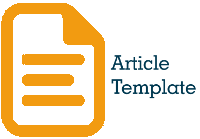APPLICATION OF THE MULTIMEDIA DEVELOPMENT LIFE CYCLE (MDLC) METHOD ON A MAGICAL AUGMENTED REALITY BOOK BASED ON ANDROID
DOI:
https://doi.org/10.35457/antivirus.v17i1.2801Keywords:
Augmented Reality, Multimedia Development Life Cycle, Learning Media, FolkloreAbstract
The development of Information and Communication Technology is currently very rapid, so it is either used or utilized in the world of education, which has a positive impact. On the other hand, technology can also hurt children under 6 years of age who are still in developmental stages, such as being lazy to move and not interacting with the outside world, so the desire to learn at school and home will decrease. One example of good learning media for children is Augmented Reality (AR) technology. AR is a technology that combines two-dimensional and or three-dimensional virtual objects into a real three-dimensional environment and then projects these virtual objects in real-time. This AR technology can insert certain information into the virtual world and display it in the real world. AR technology helps to create a moving 3D object. This is the background for making applications that help introduce technology into books with the theme of Suro and Boyo folklore which can be used as learning tools and an introduction to the origins of regions in Indonesia. The Multimedia Development Life Cycle (MDLC) method was implemented in this application. The main target of this application is Kindergarten-aged children, which has been implemented to determine the application acceptance rate of 70%.
Downloads
References
[2] S. Fitri, “Dampak Positif Dan Negatif Sosial Media Terhadap Perubahan Sosial Anak,” Nat. J. Kaji. Penelit. Pendidik. dan Pembelajaran, vol. 1, no. 2, pp. 118–123, 2017, doi: 10.35568/naturalistic.v1i2.5.
[3] A. Nizar and S. Hajaroh, “Pengaruh Intensitas Penggunaan Game Gadget Terhadap Minat Belajar Siswa,” El Midad, vol. 11, no. 2, pp. 169–192, 2019, doi: 10.20414/elmidad.v11i2.1901.
[4] A. A. Kurniasari, T. Dwi Puspitasari, L. Kurniasari, and P. N. Jember, “ARIOT: Permainan Edukasi Pertanian Cerdas Sebagai Upaya Menumbuhkan Agro-Entrepreneurship Pada Siswa Penyandang Disabilitas Tuna Rungu,” J. Sains Komput. Inform. (J-SAKTI, vol. 6, no. 2, pp. 1087–1101, 2022, [Online].
[5] A. Nugroho and B. A. Pramono, “Aplikasi Mobile Augmented Reality Berbasis Vuforia Dan Unity Pada Pengenalan Objek 3D Dengan Studi Kasus Gedung M Universitas Semarang,” J. Transform., vol. 14, no. 2, p. 86, 2017, doi: 10.26623/transformatika.v14i2.442.
[6] U. Usmaedi, P. Y. Fatmawati, and A. Karisman, “Pengembangan Media Pembelajaran Berbasis Teknologi Aplikasi Augmented Reality Dalam Meningkatkan Proses Pengajaran Siswa Sekolah Dasar,” J. Educ. FKIP UNMA, vol. 6, no. 2, pp. 489–499, 2020, doi: 10.31949/educatio.v6i2.595.
[7] J. Dwi Gotama, Y. Fernando, and D. Pasha, “Pengenalan Gedung Universitas Teknokrat Indonesia Berbasis Augmented Reality,” J. Inform. dan Rekayasa Perangkat Lunak, vol. 2, no. 1, pp. 28–38, 2021, [Online]. Available: http://jim.teknokrat.ac.id/index.php/informatika
[8] A. rinaldi D. Subandi, Husein Odi Nuriawan, “Augmented Reality dalam Mendeteksi Produk Rotan menggunakan Metode Multimedia Development Life Cycle ( MDLC ),” Means (Media Inf. Anal. dan Sist., vol. 6, no. 2, pp. 135–141, 2021.
[9] R. Damanik and W. Ginting, “Implementasi Tik Pada Badan Usaha Milik Desa (Bumdes) Dengan Model Multimedia Development Life Cycle (MDLC) Untuk Informasi Digital Pariwisata Sebagai Peningkatan Kualitas Layanan Pengunjung Desa Wisata Dokan,” Jik, vol. 5, no. 1, pp. 1–9, 2021.
[10] R. I. Borman and Y. Purwanto, “Impelementasi Multimedia Development Life Cycle pada Pengembangan Game Edukasi Pengenalan Bahaya Sampah pada Anak,” J. Edukasi dan Penelit. Inform., vol. 5, no. 2, p. 119, 2019, doi: 10.26418/jp.v5i2.25997.
[11] R. Arliza, I. Setiawan, and A. Yani, “Pengembangan Media Pembelajaran Interaktif Berbasis Android Materi Budaya Nasional Dan Interaksi Global Pendidikan Geografi,” J. Petik, vol. 5, no. 1, pp. 77–84, 2019.
[12] D. Tresnawati, L. Fitriani, and H. Mubarok, “Pendekatan MDLC untuk Media Pembelajaran Pengenalan HIV/AIDS Berbasis Android,” J. Algoritm., vol. 17, no. 2, pp. 354–360, 2021, doi: 10.33364/algoritma/v.17-2.354.
[13] J. P. R. I. Pratama, “Perancangan dan implementasi animated sticker sebagai media edukasi mengenai COVID-19 dengan menggunakan metode MDLC,” Sci. TECH J. Ilm. Ilmu Pengetah. dan Teknol., vol. 7, no. 2, pp. 1–12, 2021, [Online]. Available: https://jurnal.ustjogja.ac.id/index.php/sciencetech/article/view/9190
[14] P. R. Shalih and I. Irfansyah, “Perancangan Game Berbasis Multimedia Development Life Cycle (MDLC) Tentang Tokoh Pahlawan Indonesia Masa Kini untuk Generasi Z,” Edsence J. Pendidik. Multimed., vol. 2, no. 2, pp. 83–92, 2020, doi: 10.17509/edsence.v2i2.26690.
[15] K. S. Mustagfaroh, F. N. Putra, and R. S. Ajeng, “Pengembangan Media Pembelajaran Interaktif dengan MDLC Untuk Materi Benda dan Perubahan Sifatnya,” JACIS J. Autom. Comput. Inf. Syst., vol. 1, no. 2, pp. 100–109, 2021.
[16] A. Maulana, V. Rosalina, and E. Safaah, “Implementasi Teknologi Virtual Tour Perpustakaan Menggunakan Metode Pengembangan Multimedia Development Life Cycle (Mdlc),” JSiI (Jurnal Sist. Informasi), vol. 7, no. 1, p. 1, 2020, doi: 10.30656/jsii.v7i1.1875.
[17] A. I. Warnilah, “Implementasi Alpha Cronbach pada Pengembangan Pembelajaran Pengenalan Sampah Metode MDLC,” Produktif, vol. 2, no. 1, pp. 18–29, 2018.
Downloads
Published
Issue
Section
License
Authors who publish with this journal agree to the following terms:
- Copyright on any article is retained by the author(s).
- Author grant the journal, right of first publication with the work simultaneously licensed under a Creative Commons Attribution License that allows others to share the work with an acknowledgement of the work’s authorship and initial publication in this journal.
- Authors are able to enter into separate, additional contractual arrangements for the non-exclusive distribution of the journal’s published version of the work (e.g., post it to an institutional repository or publish it in a book), with an acknowledgement of its initial publication in this journal.
- Authors are permitted and encouraged to post their work online (e.g., in institutional repositories or on their website) prior to and during the submission process, as it can lead to productive exchanges, as well as earlier and greater citation of published work.
- The article and any associated published material is distributed under the Creative Commons Attribution-ShareAlike 4.0 International License











